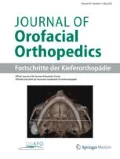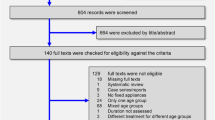Abstract
Purpose
Although several prescriptions and techniques exist for comprehensive fixed appliance treatment, their treatment effects have not yet been adequately assessed in an evidence-based manner. The aim of this systematic review was to assess the therapeutic and adverse effects of various prescriptions or techniques for orthodontic appliances from randomized clinical trials on human patients.
Methods
Eight databases were searched up to July 2016 for randomized trials assessing any orthodontic prescriptions or techniques in human patients. After elimination of duplicate studies, data extraction, and risk of bias assessment according to the Cochrane guidelines, random effects meta-analyses with mean differences (MD) and their 95% confidence intervals (CIs) were performed.
Results
Compared to Roth preadjusted appliances, both Begg and modified Begg appliances were associated with statistically significantly worse occlusal outcome assessed with Peer Assessment Review (PAR) scores (1 trial, MD 3.1 points, 95% CI 1.9–4.3 points and 1 trial, MD 2.4 points, 95% CI 1.2–3.6 points, respectively) with low quality of evidence, due to bias and imprecision. Compared to a partially programmed fixed orthodontic appliance, a fully programmed appliance was associated with a statistically significant, but clinically irrelevant increase in treatment duration (1 trial, MD 2.4 months, 95% CI 0.6–4.2 months), supported by high quality of evidence. However, caution is needed in the interpretation of these results as only a limited number of small trials with methodological issues were available.
Conclusions
Based on existing trials, there is limited evidence to support any robust clinical recommendation regarding the prescriptions or techniques for fixed orthodontic appliances.
Registration: PROSPERO (CRD42016042727).
Funding: None.
Zusammenfassung
Zielsetzung
Zwar gibt es etliche Systeme und Techniken für eine umfassende Behandlung mit festsitzenden kieferorthopädischen Apparaturen, doch ihre Effekte sind noch nicht angemessen evidenzbasiert erforscht worden. Ziel dieses systematischen Reviews war die Untersuchung von sowohl therapeutisch erwünschten als auch unerwünschten Auswirkungen unterschiedlicher Systeme bzw. Techniken für kieferorthopädische Apparaturen mittels randomisierter klinischer Studien an menschlichen Patienten.
Methoden
In 8 Datenbanken wurde nach randomisierten klinischen Humanstudien zu kieferorthopädischen Systemen oder Techniken recherchiert. Nach Eliminierung von Duplikaten, Datenextraktion und Einsatz des Risk-of-Bias-Tools der Cochrane Collaboration wurden Metaanalysen unter Anwendung eines random effect model sowie von mittleren Differenzen (mean differences, MDs) und deren 95% Konfidenzintervallen (KI) durchgeführt.
Ergebnisse
Im Vergleich mit den Roth-Apparaturen zeigten sowohl die Begg- als auch die modifizierten Begg-Apparaturen nach PAR(“peer assessement review”)-Scores (eine Studie, MD 3,1 Punkte, 95%-KI 1,9-4,3; eine Studie, MD 2,4 Punkte, 95%-KI 1,2-3,6) ein hinsichtlich der Okklusion statistisch signifikant ungünstigeres Outcome, allerdings mit geringer Evidenzqualität bedingt durch Bias und mangende Präzision. Verglichen mit einer teilweise programmierten festsitzenden kieferorthopädischen Apparatur war eine vollständig programmierte Apparatur assoziiert mit einer statistisch signifikanten, klinisch jedoch weitgehend irrelevanten Verlängerung der Behandlungsdauer (eine Studie, MD 2,4, 95%-KI 0,6-4,2 Monate), unterstützt durch eine hohe Evidenz-Qualität. Da nur eine begrenzte Anzahl kleiner, methodisch nicht unproblematischer Studien zur Verfügung stand, sind diese Ergebnisse allerdings mit Vorsicht zu interpretieren.
Schlussfolgerungen
Auf der Basis verfügbarer Studien besteht nur eine sehr limitierte Datenlage, anhand derer sich klinische Empfehlungen hinsichtlich Systeme bzw. Techniken für festsitzende kieferorthopädische Apparaturen evidenzbasiert unterstützen ließen.


Similar content being viewed by others
References
Akhoundi MS, Hashem A, Noroozi H (2009) Comparison of occlusal balance contacts in patients treated with standard edgewise and preadjusted straight-wire appliances. World J Orthod 10:216–219
Alexander RG (2001) The principles of the alexander discipline. Semin Orthod 7:62–66
Altug-Atac AT, Erdem D, Arat ZM (2008) Three-dimensional bimetric maxillary distalization arches compared with a modified Begg intraoral distalization system. Eur J Orthod 30:73–79
Andrews LF (1979) The straight-wire appliance. Br J Orthod 6:125–143
Beg Z (2002) Assessment of straightwire vs standard edgewise orthodontic treatment using the Par Index. Oregon Health & Science University, Master thesis
Begg PR (1961) Light-wire technique: employing the principles of differential force. Am J Orthod 47:30–48
Booth A, Clarke M, Ghersi D, Moher D, Petticrew M, Stewart L (2011) An international registry of systematic-review protocols. Lancet 377:108–109
Burstone CJ (1981) Variable-modulus orthodontics. Am J Orthod 80:1–16
Creekmore TD, Kunik RL (1993) Straight wire: the next generation. Am J Orthod Dentofac Orthop 104:8–20
DerSimonian R, Laird N (1986) Meta-analysis in clinical trials. Control Clin Trials 7:177–188
Guyatt GH, Oxman AD, Schünemann HJ, Tugwell P, Knottnerus A (2011) GRADE guidelines: a new series of articles in the Journal of Clinical Epidemiology. J Clin Epidemiol 64:380–382
Higgins JPT, Green S (2016) Cochrane Handbook for Systematic Reviews of Interventions Version 5.1.0 [updated March 2011]. The Cochrane Collaboration, 2011. http://www.cochrane-handbook.org. Accessed 10 Aug 2016
Jain M, Varghese J, Mascarenhas R, Mogra S, Shetty S, Dhakar N (2013) Assessment of clinical outcomes of Roth and MBT bracket prescription using the American Board of Orthodontics objective grading system. Contemp Clin Dent 4:307–312
Kattner PF, Schneider BJ (1993) Comparison of Roth appliance and standard edgewise appliance treatment results. Am J Orthod Dentofac Orthop 103:24–32
Kesling CK (1992) The Tip-Edge concept: eliminating unnecessary anchorage strain. J Clin Orthod 26:165–178
Liberati A, Altman DG, Tetzlaff J, Mulrow C, Gøtzsche PC, Ioannidis JP, Clarke M, Devereaux PJ, Kleijnen J, Moher D (2009) The PRISMA statement for reporting systematic reviews and meta-analyses of studies that evaluate health care interventions: explanation and elaboration. J Clin Epidemiol 62:e1–e34
Mavragani M, Vergari A, Selliseth NJ, Bøe OE, Wisth PL (2000) A radiographic comparison of apical root resorption after orthodontic treatment with a standard edgewise and a straight-wire edgewise technique. Eur J Orthod 22:665–674
Mclaughlin R, Bennett J, Trevisi H (1997) A clinical review of the MBT orthodontic treatment program. Orthod Perspect 4:14
Merrifield L (1982) The systems of directional force. J Charles H. Tweed Int Found 10:15e29
Mittal M, Thiruvenkatachari B, Sandler PJ, Benson PE (2015) A three-dimensional comparison of torque achieved with a preadjusted edgewise appliance using a Roth or MBT prescription. Angle Orthod 85:292–297
Moesi B, Dyer F, Benson PE (2013) Roth versus MBT: does bracket prescription have an effect on the subjective outcome of pre-adjusted edgewise treatment? Eur J Orthod 35:236–243
Norman GR, Sloan JA, Wyrwich KW (2003) Interpretation of changes in health-related quality of life: the remarkable universality of half a standard deviation. Med Care 41:582–592
O’Neill J (2003) Straight-wire versus tip-edge: a randomized controlled trial. In: 32nd meeting of the annual angle society of Europe, 2003, Going
Papageorgiou SN (2014) Meta-analysis for orthodontists: part I—how to choose effect measure and statistical model. J Orthod 41:317–326
Papageorgiou SN (2014) Meta-analysis for orthodontists: part II—is all that glitters gold? J Orthod 41:327–336
Papageorgiou SN, Gölz L, Jäger A, Eliades T, Bourauel C (2016) Lingual vs. labial fixed orthodontic appliances: systematic review and meta-analysis of treatment effects. Eur J Oral Sci 124:105–118
Papageorgiou SN, Konstantinidis I, Papadopoulou K, Jager A, Bourauel C (2014) Clinical effects of pre-adjusted edgewise orthodontic brackets: a systematic review and meta-analysis. Eur J Orthod 36:350–363
Papageorgiou SN, Konstantinidis I, Papadopoulou K, Jäger A, Bourauel C (2014) A systematic review and meta-analysis of experimental clinical evidence on initial aligning archwires and archwire sequences. Orthod Craniofac Res 17:197–215
Papageorgiou SN, Papadopoulos MA, Athanasiou AE (2014) Reporting characteristics of meta-analyses in orthodontics: methodological assessment and statistical recommendations. Eur J Orthod 36:74–85
Papageorgiou SN, Xavier GM, Cobourne MT (2015) Basic study design influences the results of orthodontic clinical investigations. J Clin Epidemiol 68:1512–1522
Reukers EA, Sanderink GC, Kuijpers-Jagtman AM, van’t Hof MA (1989) Radiographic evaluation of apical root resorption with 2 different types of edgewise appliances. Results of a randomized clinical trial. J Orofac Orthop 59:100–109
Reukers HAJ (1997) Straight wire appliance versus conventional full edgewise: a prospective clinical trial. Radboud University, Doctoral thesis
Ricketts RM, Bench RW, Hilgers JJ (1972) Mandibular utility arch. The basic arch in the light progressive technique. Proc Found Orthod Res 120–5
Root TL (1981) The level anchorage system for correction of orthodontic malocclusions. Am J Orthod 80:395–410
Roth RH (1982) The straight wire appliance 17 years later. J Clin Orthod 21:632–642
Schulz KF, Altman DG, Moher D, CONSORT Group (2010) CONSORT 2010 Statement: updated guidelines for reporting parallel group randomised trials. J Clin Epidemiol 63:834–840
Shamseer L, Moher D, Clarke M, Ghersi D, Liberati A, Petticrew M, Shekelle P, Stewart LA, PRISMA-P GROUP (2015) Preferred reporting items for systematic review and meta-analysis protocols (PRISMA-P) 2015: elaboration and explanation. BMJ 349:g7647
Sharma V, Sengupta J (2009) Modifications to increase efficiency of the Begg orthodontic technique. Med J Armed Forces India 2:118–122
Soltani M, Saedi B, Mohammadi Z (2012) Outcome of MBT and standard edgewise techniques in treating Cl I malocclusion. Avicenna J Dent Res 4(2):61–65
Talapaneni AK, Supraja G, Prasad M, Kommi PB (2012) Comparison of sagittal and vertical dental changes during first phase of orthodontic treatment with MBT vs ROTH prescription. Indian J Dent Res 23:182–186
Tweed CH (1945) A philosophy of orthodontic treatment. Am J Orthod 31:74–103
Ugur T, Yukay F (1997) Normal faciolingual inclinations of tooth crowns compared with treatment groups of standard and pretorqued brackets. Am J Orthod Dentofac Orthop 112:50–57
Viazis AD (1995) Orthodontic seminar syllabus. University of South California
Wu L, Zhang M, Shao P (2007) Comparative study of anchorage loss between straight wire appliance and standard edgewise appliance. Stomatology 27(8):396–398
Acknowledgements
The authors would like to thank J. O’Neil (Kettering General Hospital, UK) for providing unpublished data.
Author information
Authors and Affiliations
Corresponding author
Ethics declarations
Conflict of interest
S Mousoulea, S.N. Papageorgiou, and T. Eliades state that they have no competing interests.
Additional information
Prof. Theodore Eliades.
Electronic supplementary material
Below is the link to the electronic supplementary material.
Rights and permissions
About this article
Cite this article
Mousoulea, S., Papageorgiou, S.N. & Eliades, T. Treatment effects of various prescriptions and techniques for fixed orthodontic appliances. J Orofac Orthop 78, 403–414 (2017). https://doi.org/10.1007/s00056-017-0094-0
Received:
Accepted:
Published:
Issue Date:
DOI: https://doi.org/10.1007/s00056-017-0094-0




